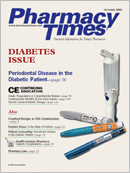Publication
Article
Pharmacy Times
Treatment Options for Nausea and Vomiting
Author(s):
One of the most universally distressing symptoms of illness is nausea, which may or may not be accompanied by vomiting. Nausea and vomiting (or emesis) can occur with pregnancy, as a side effect of medications, or as a result of a gastrointestinal disturbance or other disease state, or it may be caused by environmental factors, as in the case of motion sickness. Symptoms tend to leave patients in a weakened or fatigued state, and illnesses with accompanying nausea may require a somewhat longer recovery period.
Until recently, symptoms of nausea almost always were treated with promethazine (Phenergan) suppositories. Today's technology offers more choices, both commercially and through compounding.
A few OTC treatments are available that can be helpful in relieving nausea, vomiting, and dizziness. Dimenhydrinate (Dramamine) and meclizine (Bonine) are perennial favorites for treating symptoms associated with motion sickness. Emetrol (consisting of dextrose, fructose, and phosphoric acid), can be effective in treating nausea.
When OTC treatments fail to provide the needed relief, a prescription medication may be more appropriate. Commercially available options include dopamine-2 antagonists such as promethazine and prochlorperazine (Compazine), as well as 5-hydroxytryptamine-3 antagonists such as ondansetron (Zofran) and granisetron (Kytril). For motion sickness, scopolamine is a highly effective anticholinergic agent. Additional options include metoclopramide, chlorpromazine, and haloperidol.
Although commercial medications can be very effective, these medications will not be appropriate in every situation. For example, a pregnant woman who is working full-time might not be able to manage the drowsiness that is a common side effect of promethazine. For those who are unable to keep a tablet down, a suppository is an unpleasant alternative. A compounding pharmacist may be able to provide other solutions (Table).
Compounded treatments for nausea and vomiting are numerous, offering physicians increased flexibility in meeting the needs of individual patients. For example, many compounding pharmacies have had great success incorporating promethazine into a transdermal gel, which is applied to a thin-skinned area such as the wrist. This is a popular product in both pediatrics and obstetrics/gynecology practices, because it is less likely to cause drowsiness and discomfort than the tablet, suppository, or injection forms of promethazine.
Another area in which compounding can be of great benefit is hospice care. With the patient's comfort and quality of life being the ultimate goal of hospice care, an injection or suppository may not be the most comfortable way of meeting those needs. Many hospice patients suffer from nausea and vomiting as well as anxiety, and, in these cases especially, compounding can provide a more satisfactory product.
One proven solution for hospice patients is a preparation known as Gralla gel. Usually prepared in a Pluronic Lecithin Organogel (PLO) base, Gralla gel consists of haloperidol, diphenhydramine, metoclopramide, and dexamethasone.
Gralla gel is often packaged in unit-dose topical syringes for easy dosing. In addition to curbing nausea, Gralla gel has a sedative effect and can relieve anxiety.
Any of the medications in the table may be used alone or in combination. Various dosage forms may be used, including transdermal gels or creams, oral capsules, suppositories, suspensions for oral administration or for use in percutaneous endoscopic gastrostomy tubes, and even rapid-dissolve tablets. Because of its versatility and countless treatment options, as well as the ability to individualize therapy to meet the needs of the patient, compounding should be considered a valuable tool in treating nausea.
Ms. Fields is with the International Journal of Pharmaceutical Compounding and is a pharmacy technician at Innovative Pharmacy Services in Edmond, Okla.







